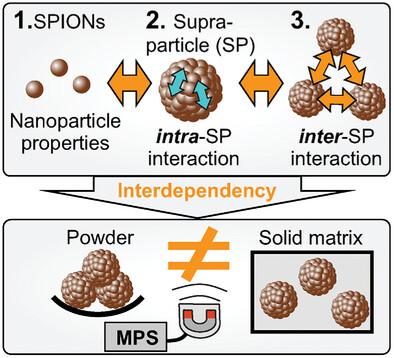Bulk Magnetic Properties Arise from Micron-Sized Supraparticle Interactions and Can be Modified on the Nanoscale
IF 13
2区 材料科学
Q1 CHEMISTRY, MULTIDISCIPLINARY
引用次数: 0
Abstract
Magnetic supraparticles (SPs) can be employed as micron-sized particulate additives in arbitrary objects to serve as ID-tag or recorder of environmental triggers. Combined with magnetic particle spectroscopy (MPS), which enables read-out of the magnetic information in ambient conditions within seconds, magnetic SPs represent a powerful approach to equip materials with information. The encoded information relies on magnetic interactions within the SPs (intra-SP interactions) of chosen nanoparticles (NPs). However, possible magnetic interactions between SPs (inter-SP interactions), that might alter the MPS signal as well, have been neglected so far. Herein, it is elucidated that significant inter-SP interactions exist and that they can be tailored via adjustments in the SP structure, i.e., by defined adjustments of their intra-interaction as revealed by 3D-MuMax simulations and experiments in viscous fluids. Superparamagnetic iron oxide nanoparticle-based SP powders with strong inter-SP interactions exhibit significantly different MPS signals compared to their state after being incorporated into a matrix. Powders with weak inter-SP interactions (achieved by integration of non-magnetic SiO2 nanoparticles) show almost no signal change before and after incorporation. Both extremes of inter-SP interactions can be beneficial for various application scenarios and can be tailored on the nano-scale due to the interdependency of intra- and inter-SP interactions.

求助全文
约1分钟内获得全文
求助全文
来源期刊

Small
工程技术-材料科学:综合
CiteScore
17.70
自引率
3.80%
发文量
1830
审稿时长
2.1 months
期刊介绍:
Small serves as an exceptional platform for both experimental and theoretical studies in fundamental and applied interdisciplinary research at the nano- and microscale. The journal offers a compelling mix of peer-reviewed Research Articles, Reviews, Perspectives, and Comments.
With a remarkable 2022 Journal Impact Factor of 13.3 (Journal Citation Reports from Clarivate Analytics, 2023), Small remains among the top multidisciplinary journals, covering a wide range of topics at the interface of materials science, chemistry, physics, engineering, medicine, and biology.
Small's readership includes biochemists, biologists, biomedical scientists, chemists, engineers, information technologists, materials scientists, physicists, and theoreticians alike.
 求助内容:
求助内容: 应助结果提醒方式:
应助结果提醒方式:


